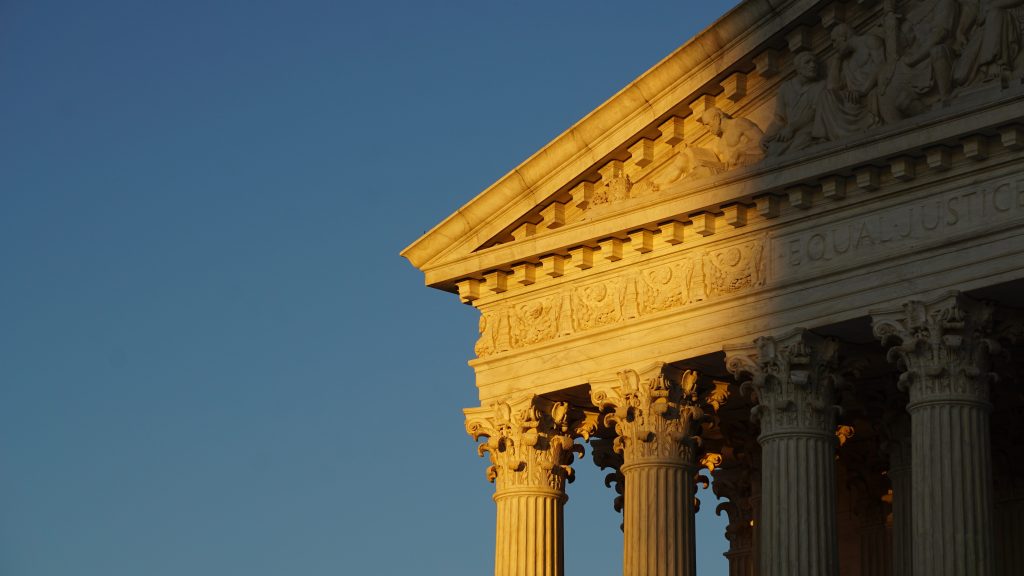- In a 6-3 ruling, the Supreme Court blocks the Occupational Safety and Health Administration’s emergency temporary standard on workplace policies for COVID-19 vaccination and testing requirements
- Majority opinion concurs that the rule is too broad in its scope, while the dissent says this step will stymie OSHA’s efforts to stem COVID-19 infections in the workplace
- Individual businesses can still opt to establish their own policies, and language in the majority opinion hints that more targeted rules on COVID-19 would be more acceptable
Summary by Dirk Langeveld
The Supreme Court has blocked an Occupational Safety and Health Administration emergency temporary standard that would have established COVID-19 vaccination requirements for an estimated 84 million workers, with the majority ruling that the rule exceeds OSHA’s authority.
The court’s 6-3 majority criticized the standard as a “blunt instrument,” addressing a broader public health hazard rather than an occupational one. In a fiery dissent, the minority defended OSHA’s authority on the issue and said the ruling inhibits efforts to combat the COVID-19 pandemic.
The court has upheld state-level vaccine requirements for certain industries and settings, but proved to be more skeptical of OSHA’s authority to issue vaccination requirements under a 1970 law permitting the agency to create emergency temporary standards to address issues causing a “grave danger” to workers. However, the majority opinion leaves open the possibility of more targeted regulations directed at workplaces where COVID-19 could represent an occupational hazard.
In a separate ruling, the justices ruled 5-4 to uphold the Biden administration’s mandate that health care workers at facilities receiving federal funds must be vaccinated.
Proposed rule
The OSHA rule, first published in the Federal Register on Nov. 5, applies to businesses with 100 or more employees. The standard sought to have these workplaces create a record of employees’ vaccination status, require unvaccinated workers in contact with others to wear a face covering, and grant employees reasonable time off to get vaccinated. It also said qualifying workplaces should begin requiring workers to either get vaccinated or test weekly for COVID-19.
The standard exempted certain employees, including fully remote workers, those who did not interact with others in their workplace, and those working exclusively outdoors. Businesses found to be in violation of the standard would have been subject to a fine of up to $13,653, or 10 times this amount of a willful or repeated offense.
The rule quickly came under several legal challenges, which included assertions that the standard did not have an adequate public comment period and that a vaccination and testing rule would need to be established by Congress rather than OSHA. Critics also charged that the rule would lead to high compliance costs and significant departures from the workforce.
The U.S. Court of Appeals for the Fifth Circuit ordered a stay on the rule, but this order was lifted after a judicial panel of the U.S. Court of Appeals for the Sixth Circuit determined that OSHA had the authority to issue the requirements. Under the new deadlines set by the agency, OSHA said it would begin enforcing the rule on Jan. 10 and that the test-or-vaccinate rule would go into effect on Feb. 9.
The Sixth Circuit decision was appealed to the Supreme Court, which last Friday heard arguments on a consolidated set of challenges from several business groups as well as a coalition of 27 state attorneys general.
Majority opinion
The majority’s opinion was largely based on the assertion that OSHA lacks the authority to dictate the requirements outlined in the emergency temporary standard. It noted how emergency temporary standards have been rarely used, issued only nine times before the COVID-19 pandemic, and historically faced an uphill battle – six of the rules were challenged in court, with only one implemented in full.
“The question before us is not how to respond to the pandemic, but who holds the power to do so. The answer is clear: Under the law as it stands today, that power rests with the States and Congress, not OSHA,” the majority opinion states. “In saying this much, we do not impugn the intentions behind the agency’s mandate. Instead, we only discharge our duty to enforce the law’s demands when it comes to the question who may govern the lives of 84 million Americans.”
The opinion holds that while the law permits emergency temporary standards to be used for workplace safety standards, it does not extend to “broad public health measures.” The justices in the majority said that permitting the rule to stand would represent a significant expansion of OSHA’s regulatory power without the congressional action needed to approve it.
“Although COVID-19 is a risk that occurs in many workplaces, it is not an occupational hazard in most,” the opinion states. “COVID-19 can and does spread at home, in schools, during sporting events, and everywhere else that people gather. That kind of universal risk is no different from the day-to-day dangers that all face from crime, air pollution, or any number of communicable diseases.”
The justices’ criticism also included an assertion that the exemptions under the rule were “largely illusory,” with only 9 percent of landscapers and groundskeepers qualifying as working exclusively outdoors. It was also skeptical of the rule’s application across industries, saying it drew no distinctions based on industry or risk of exposure to COVID-19.
The majority said OSHA still has the authority to regulate occupation-related risks to COVID-19, such as in crowded or cramped environments, thus hinting that a narrower rule incorporating these considerations might win more support.
“Where the virus poses a special danger because of the particular features of an employee’s job or workplace, targeted regulations are plainly permissible,” the opinion says.
Dissent
The three dissenting justices–Stephen Breyer, Elena Kagan, and Sonia Sotomayor–denounced the majority ruling, saying it was “contravening clear legal principles” and inhibiting the nation’s response to the COVID-19 pandemic. It noted OSHA’s estimates that the rule would prevent an 250,000 hospitalizations and 6,500 deaths, and also cited the recent surge in COVID-19 infections resulting from the Omicron variant.
“It is perverse, given these circumstances, to read the [Occupational Safety and Health] Act’s grant of emergency powers in the way the majority does— as constraining OSHA from addressing one of the gravest workplace hazards in the agency’s history,” the dissent reads.
The emergency temporary standard includes a lengthy rationale for the need for COVID-19 vaccination policies. The three justices said the rule demonstrates how the pandemic fits the definition of a “grave danger” and why the standard is needed to help fight the spread of the virus in workplace environments. The dissent also said the rule is not a mandate, since it allows exemptions and allows workers to forgo vaccination in favor of weekly testing.
The dissent further argues that the law does not dictate that OSHA cannot issue workforce regulations for hazards that exist outside the workforce, comparing the standard to regulations addressing issues such as fire and electrical risks. The justices also said that OSHA has previously issued rules that apply to all or most workplaces as well as regulations on infectious diseases, including ones facilitating vaccination.
“When we are wise, we know enough to defer on matters like this one. When we are wise, we know not to displace the judgments of experts, acting within the sphere Congress marked out and under Presidential control, to deal with emergency conditions. Today, we are not wise,” the dissent declares. “In the face of a still-raging pandemic, this Court tells the agency charged with protecting worker safety that it may not do so in all the workplaces needed.”
Reaction
The National Federation of Independent Business, one of the lead parties in the lawsuit challenging the emergency temporary standard, praised the Supreme Court’s ruling.
“Today’s decision is welcome relief for America’s small businesses, who are still trying to get their business back on track since the beginning of the pandemic,” said Karen Harned, Executive Director of NFIB’s Small Business Legal Center. “As small businesses try to recover after almost two years of significant business disruptions, the last thing they need is a mandate that would cause more business challenges.”
Secretary of Labor Marty Walsh stood by the standard, saying it was “based on science and data that show the effectiveness of vaccines against the spread of coronavirus and the grave danger faced by unvaccinated workers.” He said OSHA will evaluate other options to establish protections in the workforce against COVID-19.
“I am disappointed in the court’s decision, which is a major setback to the health and safety of workers across the country,” said Walsh. “OSHA stands by the Vaccination and Testing Emergency Temporary Standard as the best way to protect the nation’s workforce from a deadly virus that is infecting more than 750,000 Americans each day and has taken the lives of nearly a million Americans.”
The state of vaccine rules
Employers have been coping with seesawing legal decisions on COVID-19 vaccination and testing, and the issue has been further complicated by the patchwork of rules on this issue. Some state governors have pursued an aggressive vaccination strategy, including rules in Connecticut requiring employees, contractors, and volunteers in several industries to be vaccinated unless they have received a medical or religious exemption. Other governors have issued executive orders explicitly barring businesses from requiring COVID-19 vaccines as a condition of employment.
While many employers voluntarily established their own COVID-19 vaccination policies, the Supreme Court decision will likely sour some employers on taking this step. A Willis Towers Watson survey found that 57 percent of employers were planning to establish vaccination rules at their workplace, but that this included 32 percent who would only do so if the OSHA rule went into effect.
Walsh encouraged employers to continue to require workers to get vaccinated or test weekly for COVID-19 to help stem workplace infections. OSHA’s guidance on this issue says it is designed to protect unvaccinated and otherwise at-risk employees from contracting the virus.
The Connecticut Business & Industry Association says Connecticut employers still have the right to establish their own COVID-19 vaccination requirements with exemptions permitted for medical or religious reasons. The organization says any such rules may need to be negotiated with unions in some cases.








